Eugène Atget, the Balzac of the Camera
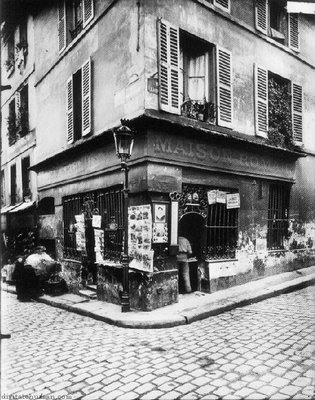
(Click here for the Romanian Version)
This Maison Romano might once have been a tavern or a wine shop, for that is the story told by the wrought iron grapes above the door. Besides, that's the title of the photo, Cabaret Rue Mouffetard.
It could have been also an optician's shop in some older days, as the pince-nez hanging just near the door is suggesting.
The photo was taken by 1898 - 1900. Is it still there the Maison Romano? It seems that they demolished the building by 1907. Or, who knows? It could be still there this building, by some Parisian miracle, and they could sell now newspapers, photographs and useful signs (such as chambre à louer, why not?). One thing is sure, whether still there or no more, it has seen better days and busier times this Maison Romano, Rue Mouffetard coin Rue de l'Arbalète. Busier times and heavier use, with lots of patrons.
Cabaret Rue Mouffetard, one of the most famous images made by Eugène Atget - the artist photograph considered to be the Balzac of the Camera. More than ten thousand photos, the chronicle of a whole epoch. Their Paris is no more, still these streets, and buildings, and people, live in Atget's photos, as in Balzac's pages.
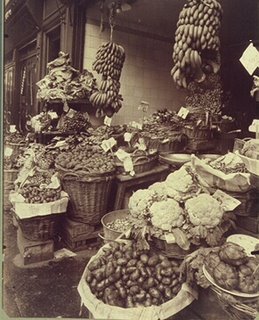
Here is another image from Rue Mouffetard.
His work is a simple revelation of the simplest aspects of his environment. Atget's prints are direct and emotionally clean records of a rare and subtle perception, and represent perhaps the earliest expression of true photographic art (Ansel Adams)
Rue Mouffetard... from immemorial times, a neighborhood for the poor, the adventurers, the artists. The Place de la Contrescarpe was, like her sister, Place de l'Estrapade, just beyond the rampart of Philippe-Auguste. La Porte Bordelle was there, opening on Rue Mouffetard. But there was also the proximity with the universities... a professor of the Sorbonne could rub elbows there with penniless poets like Verlaine, or poor writers like Hemingway, or just broke students.
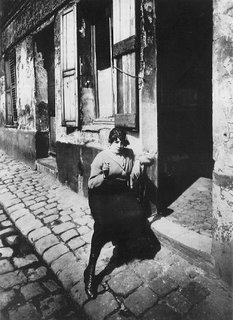 The image of a prostitute, the photo was made in 1920.
The image of a prostitute, the photo was made in 1920.Simple composition in his photos - Atget was taking pictures in the early morning when the streets were relatively empty. He was not trying great effects. Only the characters and the scenery mattered.
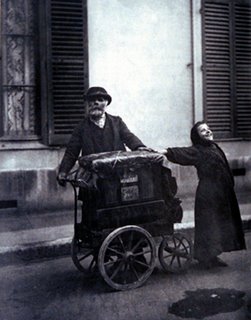 Look at this Organ Grinder, considered also one of his masterpieces, along with the Cabaret Rue Mouffetard. There are authors who let their characters live on their own - Atget was one of those. Other authors impose the tyranny of their plot (or of their agenda) - but Atget, like Ozu in his movies, or like Chekhov in his plays, let the characters free, and only follow them attentively. Others would exploit the scenery to express their ideas, but for Atget a run-down house was just that, no more. A sense of humility - such creators forget about themselves and focus on what they see - discovering this way the fabulous hidden in the ordinary.
Look at this Organ Grinder, considered also one of his masterpieces, along with the Cabaret Rue Mouffetard. There are authors who let their characters live on their own - Atget was one of those. Other authors impose the tyranny of their plot (or of their agenda) - but Atget, like Ozu in his movies, or like Chekhov in his plays, let the characters free, and only follow them attentively. Others would exploit the scenery to express their ideas, but for Atget a run-down house was just that, no more. A sense of humility - such creators forget about themselves and focus on what they see - discovering this way the fabulous hidden in the ordinary.Such an insight for what he was seeing... where did this insight come from? Orphaned at seven, a sailor and cabin boy on transatlantic liners in his very early twenties, then a bit player for a theatrical company of second-rate repertory, before becoming a photographer... well, his eyes had learned the book of life.
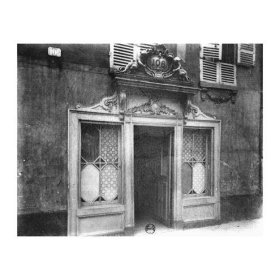 106 Rue de Suffrenne, Entrance of a Brothel, the photo is made by 1900.
106 Rue de Suffrenne, Entrance of a Brothel, the photo is made by 1900.Atget settled in Paris, as a painter-turned-photographer in the 1890s. Fellow photographer Berenice Abbott is given much credit for the recognition that Atget's photographs received after his death in 1927. She coined for him that expression, Balzac of the Camera. When Atget died, Abbott partnered with the American Julien Levy to raise the money to acquire 1,500 of the negatives and 8,000 prints. She spent the next forty years promoting his work in America. In 1968 the Museum of Modern Art in New York purchased Abbott's collection of Atget's work.
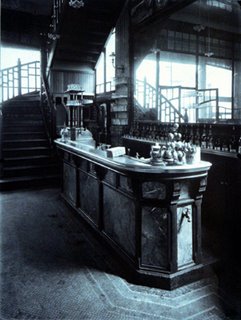
I had read about Atget and I was looking for his photos on the web. I found firstly this one, Bar de Cabaret, Marchand de Vin, Rue Boyer, then the others followed.
And in the end I found one of the best photos ever made, Au Tambour.
Labels: Atget

0 Comments:
Post a Comment
<< Home